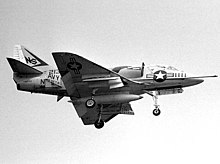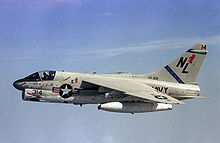VFA-22
| Strike Fighter Squadron 22 | |
|---|---|
 VFA-22 Insignia | |
| Active | 1948 |
| Country | United States |
| Branch | United States Navy |
| Type | Fighter/Attack |
| Role | Close air support Air interdiction Aerial reconnaissance |
| Garrison/HQ | NAS Lemoore |
| Nickname(s) | Fighting Redcocks |
| Motto(s) | "You Can't Beat A Redcock" |
| Engagements | Korean War Vietnam War Operation Southern Watch Operation Desert Fox Operation Enduring Freedom |
| Commanders | |
| Current commander | CDR C.W. 'GATOR' Chope, USN |
Strike Fighter Squadron 22 (VFA-22), also known as the "Fighting Redcocks", are a United States Navy F/A-18F Super Hornet fighter squadron stationed at Naval Air Station Lemoore. Their tail code is NK.
History

Strike Fighter Squadron 22 was originally commissioned as Fighter Squadron 63 at Naval Air Station Norfolk, Virginia in 1948, the squadron was re-designated as Attack Squadron 22 in July 1959. The first Redcock aviators flew the F8F Bearcat. Later, Redcocks flew the F4U Corsair, F9F Panther, F9F Cougar, FJ4 Fury, A-4 Skyhawk, A-7 Corsair II, and the FA-18C Hornet. Today, the 220 enlisted men and women and 40 officers of VFA-22 are based in NAS Lemoore, California, and has completed the transition from the F/A-18E to the F/A-18F Super Hornet.
Over the years, the squadron completed three combat deployments during the Korean War and six combat deployments during the Vietnam War. In April 1988, while in the Persian Gulf, VA-22 aircraft participated in sinking the Iranian Frigate Sahand which fired missiles at two American A-6 Intruders. In 1993, the Fighting Redcocks deployed aboard the USS Abraham Lincoln (CVN-72) to the Persian Gulf and participated in Operation Southern Watch, enforcing the United Nations Southern no-fly zone sanctions over Iraq. Before returning home from deployment, the squadron diverted to the coast of Somalia and provided air support during Operation Continue Hope.

In December 1998, VFA-22 led the only Carrier Air Wing 11 air strike of Operation Desert Fox. In October 2001, VFA-22 was the first on the scene with USS Carl Vinson (CVN-70) to perform strikes against Taliban and Al Qaeda forces in Afghanistan in support of Operation Enduring Freedom . In 2003, VFA-22 deployed with Carrier Air Wing 9 on board the "Carl Vinson" on an extended eight month Western Pacific deployment in support of the Global War on Terrorism. In July, 2004, VFA-22 transitioned to F/A-18 E Super Hornets, and in January, 2006, deployed with Carrier Air Wing 14 on board the USS Ronald Reagan for six months in support of the Global War on Terrorism.
In early 2007, VFA-22, made a surge deployment with Carrier Air Wing 14 and USS Ronald Reagan to the Pacific Ocean with a mixed unit of F/A-18E and F/A-18F as the unit was in the middle of transitioning to the two seater.[1] By the end of 2007, VFA-22 had transitioned to the F/A-18F Super Hornet.[2]
Notes
- ^ Plane captain Aviation Machinist's Mate Airman Rodney Hunter, from Cleveland, Ohio, cleans the canopy and prepares an F/A-18F Super Hornet.
- ^ The aircrew of an F/A-18F Super Hornet, assigned to the "Fighting Redcocks" of Strike Fighter Squadron (VFA) 22, wait to launch from Catapult 3 during night flight operations.
